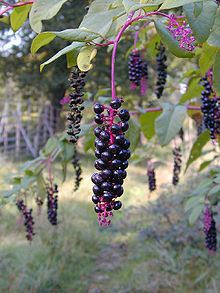Pokeweed is probably one of the most beloved and controversial wild edible and medicinal plants in the eastern third of the United States. Young poke is an important browse for deer and the berries are relished by songbirds and wild ducks (my domestic ducks would do backflips for pokeberries!).
As for humans, recent studies verify that the plant contains cancer-causing compounds. Yet, those who have eaten young poke shoots and leaves for years swear that once cooked, poke is completely safe. To read more about the potential dangers of pokeweed and how to properly identify and process it for consumption, read: Pokeweed: Good Green or Toxic Weed? and A Walk on the Wild Side: Pokeweed.
Data: 30.04.2013
Link:
http://showmeoz.wordpress.com/2013/04/30/wild-walk-spring-blooms/

http://pt.wikipedia.org/wiki/Phytolacca_americana

http://pt.wikipedia.org/wiki/Phytolacca_americana
Importante também este texto como alerta do consumo da planta:
Don't Eat Poke Salad
Auburn, June 18, 2002---Pokeweed is probably the best known and most widely used wild vegetable in America and Europe. However, a food scientist with the Alabama Cooperative Extension System says no part of this plant should be eaten by a person or animal.
"The roots, berries, seeds and mature stems and leaves of pokeweed are poisonous," says Extension Food Scientist Jean Weese. There are at least three different types of poison in this plant -- phytolaccatoxin, triterpene saponins, an alkaloid, phytolaccin, and histamines.
Pokeweed, a herbaceous perennial native to America, grows from Maine to Florida and Minnesota to Texas. Indians introduced the first colonists to pokeweed, and they took it back to Europe where it became a popular vegetable. It grows along roads and fencerows, in fields and in open woods.
Early American settlers also made a crimson dye from the berry juice. Indians often used the pokeweed concoctions for a variety of internal and external medicinal applications.
The berries, which ripen in fall, are also popular with migrating songbirds, especially robins, towhees, mockingbirds, mourning doves, catbirds and bluebirds. Sometimes the birds get drunk on overly ripe berries and fly into closed windows or sides of buildings.
For years, people have picked the young shoots and developing leaves (before they take on their reddish hue) off this plant and cooked them. The plant is still used by many people today, and the tender young shoots often appear in rural vegetable markets in the South.
Most people boil the shoots and leaves for 20-30 minutes, first in salt water and again in clean water, then eat the plant much like spinach.
"The boiling process removes some of the toxins but certainly not all of them," says Weese. I suggest that people avoid this plant no matter how many times your mother or grandmother may have prepared it in the past and no matter how good it tasted. Why would you want to eat something that we know is toxic when there are so many other non-toxic plants out there we can eat?"
Source: Dr. Jean Weese, Food Scientist, Alabama Cooperative Exension System, (334) 844-3269
Data: 18.06.2002
Link:

Nenhum comentário:
Postar um comentário